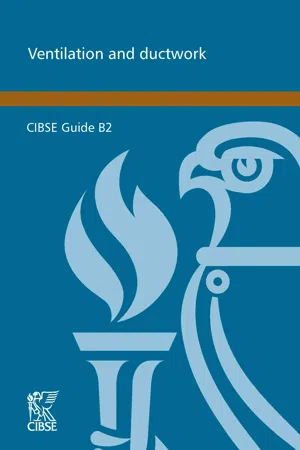
Guide B2: Ventilation and ductwork
- English
- PDF
- Available on iOS & Android
Guide B2: Ventilation and ductwork
About this book
Guide B provides guidance on the practical design of heating, ventilation and air conditioning systems. It represents a consensus on what constitutes relevant good practice guidance. This has developed over more than 70 years, with the Steering Groups for each edition of the Guide expanding and pruning the content to reflect the evolution of technology and priorities.Since the last edition of Guide B in 2005, the European Energy Performance of Buildings Directive has been introduced. This requires national building energy regulations to be based on calculations that integrate the impact of the building envelope and the building services systems, formalising what was already recognised as good design practice. In addition, the use of voluntary energy efficiency and sustainability indicators has increased.These changes have influenced the content of Guide B, but the emphasis remains on system design. The guidance in Guide B is not in itself sufficient to cover every aspect of the effective design of HVAC systems. Energy (and carbon emission) calculations will also be needed, and a range of other environmental criteria may specified by the client. These may, for example, include whole-life costing or assessments of embodied energy or carbon. The balance between building fabric measures and the energy efficiency of HVAC systems is important, as is the balance between energy use for lighting and for heating, ventilation and cooling. More detailed information on energy efficiency and sustainability can be found in Guides F and L respectively. The Guide does not attempt to provide step by step design procedures: these can be found in appropriate textbooks.Guide B deals with systems to provide heating, ventilation and air conditioning services, and is divided into several chapters which are published separately. It will usually be necessary to refer to several – perhaps all – chapters since decisions based on one service will commonly affect theprovision of others.- B0: Applications and activities focuses on how different types of building and different activities within buildings influence the choice of system. This chapter is not available in printed form, but can be downloaded from the CIBSE website. For many activities and types of building, more detailed design information is available in specialist guidance.Sections B1 to B4 address issues relating to specific services. There are usually several possible design solutions to any situation, and the Guide does not attempt to be prescriptive but rather to highlight the strengths and weaknesses of different options.- B1: Heating, including hot water systems and an appendix on hydronic systems, which is also applicable to chilled water systems- B2: Ventilation and ductwork- B3: Air conditioning and refrigeration- B4: Noise and vibration control for building services systems (applicable to all systems)The focus is on application in the UK: though many aspects of the guidance apply more generally, this should not be taken for granted. The level of detail provided varies: where detailed guidance from CIBSE or other sources is readily available, Guide B is relatively brief and refers to thesesources. Examples of this are the treatment in the Guide of low carbon systems such as heat pumps, solar thermal water heating and combined heat and power. On-site energy generation such as wind power and photovoltaics are not covered.Regulatory requirements are not described in detail in the Guide – the information varies between jurisdictions and is liable to change more rapidly than the Guide can be updated. Instead, the existence of regulations is sign-posted and their general scope explained. Sometime example tablesare shown, but readers should note that these are simply examples of the type of requirement that is imposed and may not be current.While there is some discussion of relative costs, no attempt is made to provide detailed cost figuresas these are too project-specific and variable with time and location.
Frequently asked questions
- Essential is ideal for learners and professionals who enjoy exploring a wide range of subjects. Access the Essential Library with 800,000+ trusted titles and best-sellers across business, personal growth, and the humanities. Includes unlimited reading time and Standard Read Aloud voice.
- Complete: Perfect for advanced learners and researchers needing full, unrestricted access. Unlock 1.4M+ books across hundreds of subjects, including academic and specialized titles. The Complete Plan also includes advanced features like Premium Read Aloud and Research Assistant.
Please note we cannot support devices running on iOS 13 and Android 7 or earlier. Learn more about using the app.
Information
Table of contents
- CIBSE Guide B2 Ventilation and ductwork OFC
- Foreword
- Contents
- 2.1 Introduction
- 2.2 Design criteria
- 2.3 Systems
- 2.4 System design
- 2.5 Other design considerations
- 2.6 Equipment
- 2.7 Commissioning, operation and maintenance
- References
- Appendix 2.A1: Recommended sizes for ductwork
- Appendix 2.A2: Space allowances
- Appendix 2.A3: Maximum permissible air leakage rates
- Appendix 2.A4: Methods of fire protection
- Appendix 2.A5: Example calculations
- Appendix 2.A6: Techniques for assessment of ventilation
- Index